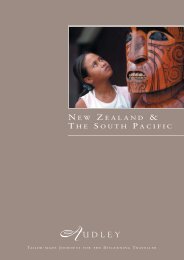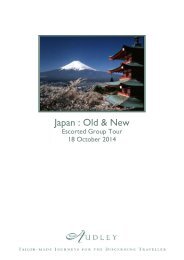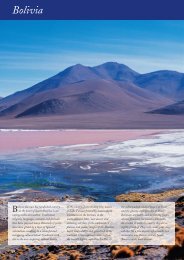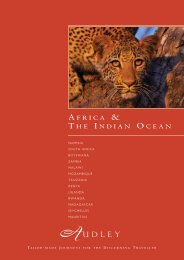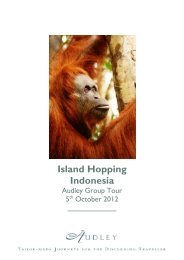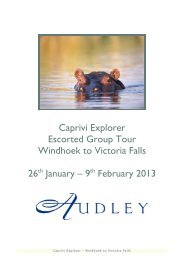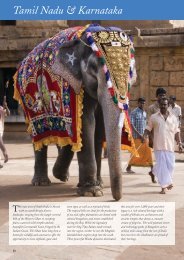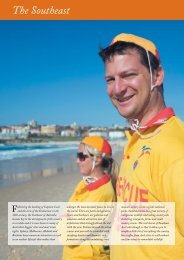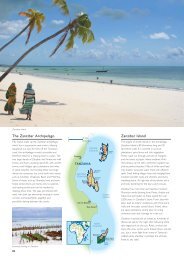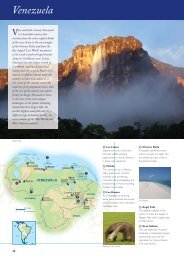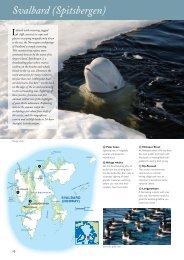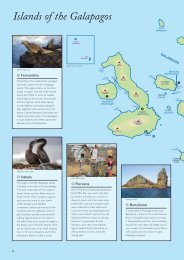Download - Audley Travel
Download - Audley Travel
Download - Audley Travel
You also want an ePaper? Increase the reach of your titles
YUMPU automatically turns print PDFs into web optimized ePapers that Google loves.
Big horn sheep<br />
Atlantic puffins<br />
Orcas cruising<br />
Bald eagle in flight<br />
they are extremely elusive and you’re more likely<br />
to hear their calls than get direct sightings. They’re<br />
most often seen in Alaska’s Denali National Park,<br />
on the Bow Valley Parkway near Lake Louise, and<br />
in Ontario’s Algonquin Provincial Park.<br />
Caribou<br />
To see a family of caribou in their tundra home<br />
is an impressive sight. Imagine then what it must<br />
be like to see one of North America’s last true<br />
migrations - the great herds of caribou, hundreds<br />
of thousands strong, that traverse thousands of<br />
kilometres across the barren tundra, following<br />
the fresh grass growth and harried by packs of<br />
wolves. A journey to the north is bound to bring<br />
you close to these magnificent animals and will<br />
surely be a highlight of your trip.<br />
Moose<br />
The moose is the largest member of the deer<br />
family and is found in forests from Alaska all the<br />
way across to the eastern tip of Newfoundland.<br />
The bulls of these imposing animals can grow larger<br />
than the tallest horse and have a rack of antlers<br />
spanning over one and a half metres in width. They<br />
have poor eyesight, skinny legs under a bulky body<br />
and a long, mournful-looking snout giving them an<br />
almost comic appearance. Some of the best places<br />
to see moose include New Brunswick, Algonquin<br />
Provincial Park and Banff and Jasper National Parks.<br />
Grizzly bears catching salmon<br />
Musk Oxen<br />
Natives of Arctic Canada, Greenland and Alaska,<br />
musk oxen are neither oxen, nor do they have<br />
musk glands; being closely related to sheep or<br />
goats. They are noted for their thick shaggy coats,<br />
long curved horns and for the strong odour<br />
emitted by the males. Their thick coats enable<br />
them to survive bitterly cold winter temperatures.<br />
Sociable animals, they usually live in herds of<br />
between ten to twenty animals but sometimes<br />
the herd can number several hundred. Musk<br />
oxen, or their ancestors, are believed to have<br />
migrated to North America between 90,000 and<br />
200,000 years ago making them a contemporary<br />
of the woolly mammoth. The largest population is<br />
on Banks Island in the Northwest Territories but<br />
herds can be found all over the northern tundra.<br />
Whales<br />
Canada and Alaska are two of the best places in<br />
the world to watch a wide variety of whales<br />
during the summer months. Humpbacks, minke<br />
and finback whales are found off the coast of<br />
Newfoundland while northern right whales and<br />
humpbacks are found slightly to the south in the<br />
Bay of Fundy. The St. Lawrence River is home to<br />
13 species of whale, including the world’s largest,<br />
the blue whale, and a large number of white<br />
beluga whales, which are also to be found<br />
Bull caribou<br />
gathering in Hudson Bay and Arctic waters. Rare<br />
narwhal can be spotted in the Arctic whilst orcas<br />
and grey whales can be found in abundance off<br />
the coasts of Vancouver Island and Alaska.<br />
Birds<br />
This vast region has an incredible variety of bird<br />
species, both resident and migratory. Alaska and<br />
western British Columbia are renowned for huge<br />
populations of bald eagles whilst the cliffs of the<br />
Maritime Provinces echo to the enthralling<br />
cacophony of shrieks and calls of some of the<br />
world’s largest seabird colonies, providing ideal<br />
nesting conditions for thousands of kittiwakes,<br />
murres and razorbills. The Queen Charlotte Islands<br />
are known as the ‘Canadian Galapagos’ and a third<br />
of the world’s population of murrelets nest here<br />
along with horned puffins and Peales peregrine<br />
falcons. Oak Hammock Marsh in southern Manitoba<br />
is one of the finest bird sanctuaries on the continent<br />
where each autumn up to half a million geese arrive<br />
on their way south. Other notable places to see<br />
birds are the remarkable Point Pelee National Park<br />
in Ontario, and the Île Bonaventure in Québec<br />
which, with 60,000 birds, is home to North<br />
America’s largest gannet colony.<br />
Wildlife<br />
Telephone: 01993 838 700<br />
11



